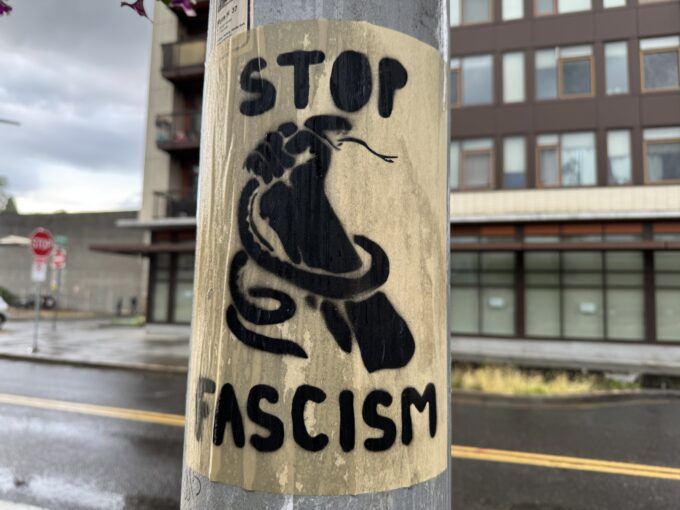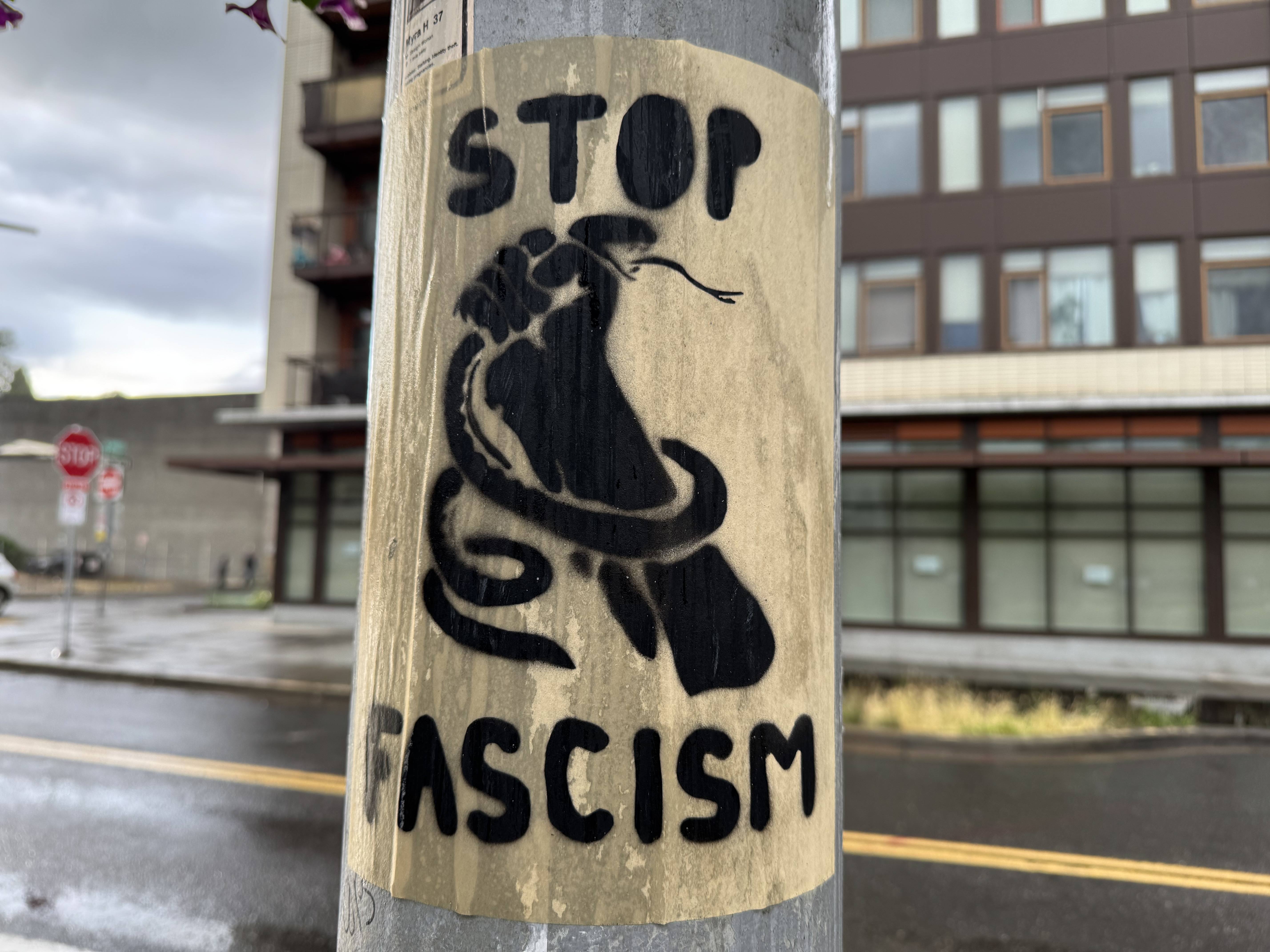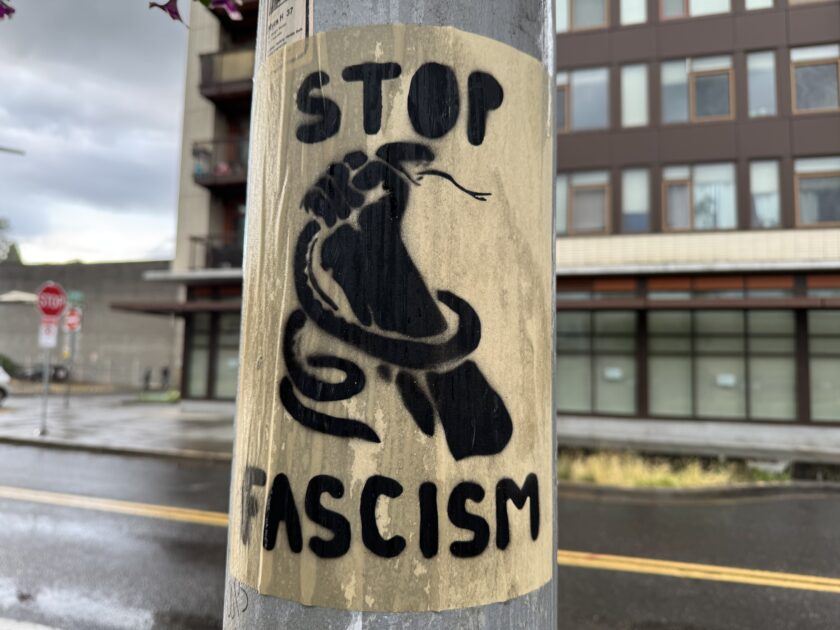






























































Photograph by Nathaniel St. Clair
At first glance, U.S. political life under Trump looks like a sprawling, circuslike affair going nowhere. However, measures are in force hitting at the rule of law and democracy itself and promoting war and turmoil in the wider world. They are so politically dangerous for most Americans as hardly to have appeared accidently. We suggest they are purposeful.
We argue that the present situation results from the U.S. government mounting a last-ditch response to a crisis of capitalism. If that is true, defense against catastrophe moving toward some horrific end point rests, it seems, on whatever is done about capitalism, which is no bed of roses.
The term signifies arrangements in effect since feudalism that give full rein to ruling classes everywhere to organize economic and political affairs to their advantage. Capitalism is an evolving process that stumbles now and then and requires adjustments to how it works. The masters of U.S. capitalism presently seem to be carrying out a major fix of old and new problems that impede profit-taking. The tools for repair are hugely disruptive.
To get the job done, capitalist decision-makers recruited the MAGA crew as agents for taking on the unpleasantness ahead. They are presently removing protections against exploitation and abuse of U.S. working people. Even the lower-order capitalists with reservations about the endeavor are joining in, perhaps holding their nose.
Some basic assumptions introduce the discussion here:
• To fix what’s wrong, you look for the cause.
• Focus on impaired personalities running the show does not fully explain the ongoing political turmoil.
• Preexisting political rules and arrangements for how to govern did nothing to prevent catastrophe.
• Wide sectors of the U.S. population are silent, stunned, and without hope. They are generally unconvinced that an alternative way of doing politics exists or is possible.
• The Trump administration regards political opposition as inconvenient, irrelevant, and disposable.
• Actions of his government result from rational decision-making. They are not the products of random impulses.
Beginnings
Capitalists cross established boundaries. Beginning centuries ago in Europe, they have been plundering distant parts of the world. Along the way, they added an exploitative factory system, great industrial monopolies, and, lastly, a world system of markets, cheap labor, and plunder of natural resources.
Overcoming challenges and contradictions, capitalists took charge of faraway peoples, fought wars against rival capitalist powers, confronted socialist governments and suppressed resistance movements at home and abroad. They occasionally have had to recover from economic crashes prompted by impoverished workers being unable to buy goods that are produced. Our point here is that capitalists are used to dealing with challenges, and doing so successfully.
Capitalists after World War I were experiencing unprecedented difficulties, and fixing them was fraught with uncertainty. European and the U.S. economies were highly unstable even before the Great Depression descended. And crucially, the Soviet Union was attending to people’s social needs, was industrializing, and was seemingly immune to the Great Depression. Capitalists were watching the abrupt arrival of the socialist alternative to their faltering system.
Many capitalists in Germany and Italy reacted by tolerating or actively supporting fascist political parties aspiring to power in each of those countries. The fascists were seen as offering protection for capitalist economies and fightback against the Soviet menace. By contrast, many U.S. capitalists endorsed palliative reforms mediated through New Deal social democracy.
U.S. capitalism took on new life after World War II as the United States shepherded the insertion of free trade and other neoliberal policies into the world economy. The U.S.-dominated system allowed rich nations and their capitalists to exploit low-wage workers abroad, take advantage of poor nations’ debt dependency, and profitably extract their underground resources.
New Troubles
The good times were not so good. Beginning in the 1970s, worldwide economic growth lagged and inflationary tendencies persisted. The U.S. economy was experiencing “long-term stagnation and deindustrialization.” Financial activities and financial assets came to loom larger in the U.S. economy than did commodity production and trade.
Manipulation of debt instruments misfired in 2008 leading to serious economic crisis. These adverse, long-developing realities motivated capitalist leaders to move toward extraordinary corrective measures. The Trump administration is dutifully carrying them out.
Warmaking by the Trump administration marks the other disruptive element currently wreaking havoc in U.S. political life. In that regard, the government of Trump is a model of consistency; no deviation of capitalist norms is contemplated. After all, as pointed out by Lenin and other critics of capitalism, aggressive foreign interventions – that is to say imperialism – is crucial for capitalism to be able to function.
Because the administration’s major task is to shore up capitalism, U.S. imperialism, a bipartisan project that gained wings after World War II, will undoubtedly thrive and do so without subterfuge. Anticommunism was often the pretext for U.S. imperialists as they launched interventions, wars, proxy wars, and devastating economic sanctions in country after country, mostly in the Global South.
But U.S. warmaking continued long after the Soviet Bloc was no more. The U.S. government and its capitalist junior partners, for example, engineered devastating regime-change operations against Yugoslavia (1999), Iraq (2003), and Libya (2011) The cover of anti-communism was gone, and antiterrorism as justification barely sufficed. Subsequently, foreign interventions happen, and purposes are taken for granted.
Now it’s enough to present U.S. intrusions for controlling oil reserves or strategically important geographical areas, or for commandeering foreign markets as representing normal U.S. policy. Those in charge are able now to leave the assumption, and have it widely accepted, that that’s what imperialists do.
China and a few other underdeveloped nations are now major manufacturing centers. China continues to attract significant foreign investment and is investing, building infrastructure, and extracting subsoil resources throughout the Global South, in the process outstripping the United States. The BRICS+ nations, competitive with the Global North in banking, manufacturing and science, are seeking to replace the U.S. dollar as the main international currency.
What to do
U.S. capitalists, seeking to bolster U.S. imperialism and worried about weaknesses of the faltering neoliberal free-trade system, are embarked upon building something new. A new kind of capitalism is on the horizon and to make it real there are the circuslike activities of the Trump administration. They are hardly accidental.
Under Trump, government is assertive, aggressively nationalistic, and insulated from progressive social and political currents from abroad. The U.S. has disconnected from international agreements and international organizations, notably the 2015 Paris Climate Accord and the World Health Organization. High import tariffs are landing on goods arriving from almost everywhere, with the highest ones reserved for Chinese products.
U.S. working people are, or soon will be, coping with price hikes stemming from high tariffs; assaults on labor organizing, healthcare, schools, and universities; selective food shortages; aggravated racism; and cruel and illegal deportation proceedings. New grief is compounding earlier unmet social and economic needs.
The changes are so far-reaching that progressive reforms introduced by President Franklin Roosevelt in the 1930s are at risk of disappearing. Breakdown of the New Deal consensus would be the crown jewel of the upcoming capitalist reformation.
Almost incidentally, war preparations are a major element of the new kind of capitalism. According to Monthly Review, “[R]earmament of U.S. allies, along with a massive increase in Pentagon spending and bellicose threats directed at designated enemies, could lead to the further proliferation of conflicts, heightening the chance of a Third World War.” A “Trump nationalist imperial policy” envisions a “New Cold War on China” involving a “limited nuclear war.”
Call in the specialists
A government embarking upon such far-reaching initiatives can expect troubles ahead. Vast numbers of U.S. Americans will be experiencing grief and abuse. They may rise up, prompting the need for their suppression and for maintenance of order. A major war would require the home front to be stabilized and subjected to vigorous controls. A special brand of governance would come into play. Specialists are available for that kind of work.
They are MAGA crew, already on the job. Following a script, they hit at the rule of law,politicize the military, prepare for war, scapegoat immigrants and the racially oppressed as internal enemies, assault institutional centers of thought –universities, government research centers, and the independent press – and rip apart the fabric of democracy. Lying and disregard for the truth are nonstop.
You may have already made the association. Another bunch of fascists thugs almost a century ago in Germany and Italy did their reordering in ways similar to those adopted by the Trump administration in our era. Measures taken in both situations are similar, as are overall purposes.
The way out
Working-class resistance becomes important. Turning back the fascists – or protofascists, call them what you will – rests on alliances created between working people and other oppressed and marginalized sectors, especially in rural areas and among the lower ranks of the middle class, the so-called petit bourgeoisie. The MAGA movement’s electoral strength depends on support from both sectors and also, crucially, from elements of the working class.
The record shows that to defeat 20th century fascism, major elements of the Communist movement pursued the popular front strategy, which envisioned a worldwide alliance involving all democratic forces. That recipe fits today and, besides, no alternative political formation or remedy is waiting in the wings for rescue.
Political activists oriented to working people and not to elite sectors may have gained familiarity, through study and political experience, with the linkage between capitalism gone awry and the origins of fascism. Proclaiming that reality is surely a first step in turning scared, confused, and disheartened members of the victim class toward active political resistance – and from there to mass mobilization, which is the essential tool for defeating fascism.
A new breed of working-class activists, and the veterans too, will be educating and organizing, and asserting their place in public life. They would interact primarily, but not exclusively, with members of the working class. Their educational message would begin with showing that when top-level capitalists are unable readily to solve their big problems, they inevitably turn to fascism for rescue. Along the way, these activist educators would highlight the connection between wars and imperialism.
Loose ends remain here. First, U.S. capitalists’ reliance on the fascists is old hat for their kind. Business mogul Henry Ford and Charles Lindbergh of America First fame greatly admired the Nazis. Senator Harry S. Truman in 1941, commenting on war in Europe, stated that, “If we see that Germany is winning, we ought to help Russia, and if Russia is winning, we ought to help Germany, and that way let them kill as many as possible.” His message was that, in the right circumstances, Nazis are OK.
Secondly, U.S. capitalists, bent upon overcoming failures in how capitalism works, easily dismiss one of the greatest failures of worldwide capitalism, that of dismissing environmental crisis that threatens to destroy humankind and the natural world.
The post Fascism and the Dangerous Logic of the Trump Circus appeared first on CounterPunch.org.
This post was originally published on CounterPunch.org.